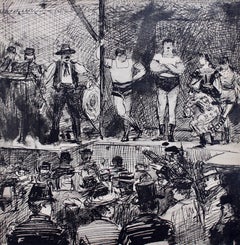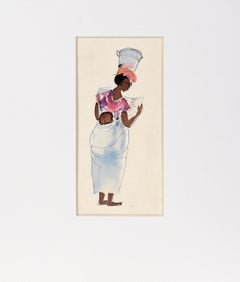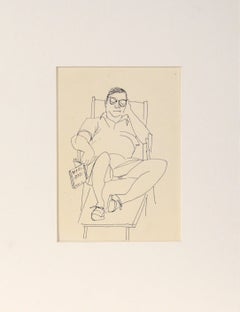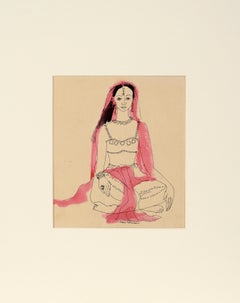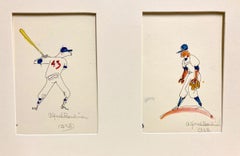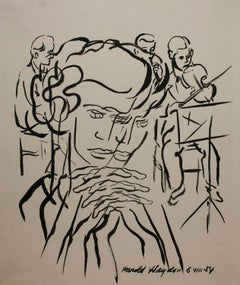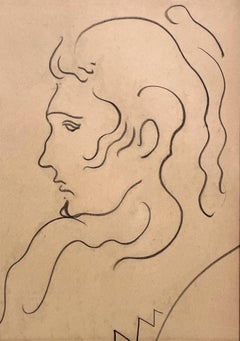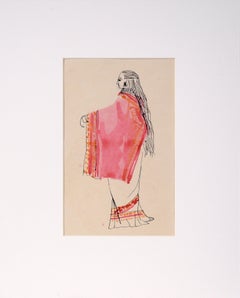India Ink Portrait Drawings and Watercolors
to
5
9
Overall Width
to
Overall Height
to
1
8
1
4
1
10
9
8
4
3
3
2
2
7
1
1
8
5
5
4
2
2
1
1
1
1
1
1
908
392
336
326
317
3
1
1
1
2
1
6
2
Style: Modern
Medium: India Ink
The Parade of Fairground Wrestlers, Modern French School
Located in London, GB
'The Parade of Fairground Wrestlers', India ink on art paper, Modern French School (early 1900s). Traveling shows often held promotional events before opening in local areas to generate enthusiasm for the spectacle. This is an intriguing depiction of the various acts on stage strutting their stuff before an audience of potential customers. On the platform, fairground wrestlers mix with clowns, dancers, a percussionist in bolero hat...
Category
Early 20th Century Modern India Ink Portrait Drawings and Watercolors
Materials
Paper, India Ink
African Mama - Vintage Illustration in Ink and Watercolor
Located in Soquel, CA
African Mama - Vintage Illustration in Ink and Watercolor
A charming illustration, by Irene Pattinson (American, 1909-1999), shows a woman with a...
Category
1950s American Modern India Ink Portrait Drawings and Watercolors
Materials
Paper, India Ink, Watercolor, Pen
Flapper Fanny - Female Cartoonist of the Golden Age
Located in Miami, FL
Flapper Fanny - Female Cartoonist of the Golden Age
Sylvia Sneidman was originally a fashion illustrator, but assumed the helm of the famous jazz-age panel cartoon "Flapper Fanny Sa...
Category
1940s American Modern India Ink Portrait Drawings and Watercolors
Materials
India Ink, Archival Paper
Lounge Chair Nap - Vintage Illustration in Ink and Watercolor
Located in Soquel, CA
Lounge Chair Nap - Vintage Illustration in Ink and Watercolor
A man lazes in a lounge chair, book still in hand, as he dozes off with a content e...
Category
1950s American Modern India Ink Portrait Drawings and Watercolors
Materials
Paper, India Ink, Pen
Indian Dancer - Vintage Illustration in Ink and Watercolor
Located in Soquel, CA
Indian Dancer - Vintage Illustration in Ink and Watercolor
A stoic, dark-haired woman in elaborate dress is sitting cross-legged in this illustration by Irene Pattinson (American, 1909-1999). Pattinson uses fine ink line detail and a vibrant pink watercolor for a splash of color.
Signed at the bottom, "Irene Pattinson."
Provenance: The Artist, Estate of Irene Pattinson: David Carlson; Estate of Larry Miller Fine Art, Robert Azensky Fine Art.
Presented in a new white mat with foam core backing.
Mat size: 16"H x 12"W
Paper size: 11.75"H x 8.5"W
Image size: 7.5"H x 6.5"W
Irene Pattinson (American, 1909-1999) studied at the California School of Fine Art (now The San Francisco Art Institute), San Francisco State College and The Marion Hartwell School of Design. She was President of the San Francisco Woman Artists Association 1955-56.
Provenance: The Artist, Estate of Irene Pattinson: David Carlson; Estate of Larry Miller Fine Art, Robert Azensky Fine Art.
Solo Exhibitions: Lucien Labaudt Gallery 1955; San Francisco Museum of Art, 1961 (39 works).
Selected Group Exhibitions: San Francisco Art Association Annual 1948, 54, 55; San Francisco Woman Artists, 1957-1960; Oakland Art Museum Annual, 1951, 58; California Palace of the Legion of Honor, 1960; Richmond Art Center, 1955, 56, 57, 58; San Francisco Art Institute 1959, 60. The Art Bank of the San Francisco Art Association, 1958, 59, 60, 62, 63; Winter Invitational, California Palace of The Legion of Honor, San Francisco, 1960; Fourth Winter Invitational, California Palace of The Legion of Honor, San Francisco, 1963.
Awards: First Place, San Francisco Woman Artists Assoc., 1957, 1959; San Francisco Art Festival 1957;Literature: San Francisco Art Institute - A catalog of the Art Ban 1962/63; San Francisco and the Second Wave: The Blair Collection
Exhibitions:
1963 The Art Bank of the San Francisco Art Association, San Francisco, CA
1963 California Palace of The Legion of Honor: Forth Winter Invitational, San Francisco, CA
1962 The Art Bank of the San Francisco Art Association, San Francisco, CA
1961 San Francisco Museum of Art, San Francisco, CA
1960 California...
Category
1950s American Modern India Ink Portrait Drawings and Watercolors
Materials
Paper, India Ink, Watercolor, Pen
Alfred Bendiner, (Baseball Hitter and Pitcher -- The Philadelphia Phillies?)
Located in New York, NY
Of course it's possible that these baseball players aren't from a Philadelphia team, but I doubt it. There was so much drama and intrigue with both the Philadelphia Phillies...
Category
Mid-20th Century American Modern India Ink Portrait Drawings and Watercolors
Materials
India Ink, Watercolor
"King of the Blues" - B.B. King Portrait in Watercolor and Ink on Paper
Located in Soquel, CA
Vibrant portrait entitled "King of the Blues" by John Martin Socha (American, 1913-1983). Bold and angular, this piece depicts an African-American man wearing a crown. Given the date of the piece (1955), it is likely a reference to B. B. King, who began topping the Billboard charts in 1953. The portrait is slightly abstracted, with ornamentation that adds detail and depth.
Signed and dated "Socha 1955" in the lower left corner.
Presented in a wood frame with a linen mat.
Frame size: 17.5"H x 14.75"W
Image size: 9.5"H x 6.5"W
John Martin Socha (American, 1913-1983) was a painter and teacher from St. Paul, Minnesota. As a teenager, Socha studied with Diego Rivera and attended the Minneapolis School of Art. He later worked as a WPA artist in the 1930s, and Rivera’s influence can be seen in his murals. Socha then served in the US Army from 1943-1946 before attending the University of Minnesota in 1947. Socha’s work has won many awards and is in the National Gallery of Art in Washington DC.
Exhibited: Minnesota State Fair, 1938-40 (prize), 1941 (prize), 1942; Minneapolis Women's Club, 1938-42 (prize); Minneapolis IA, 1938-41, 1942 (prize), 1943-46; AIC, 1941-42; MMA, 1941-42; WMAA, 1942; NGA, 1940, 1942; Guatemala City, 1940; Mexico City, 1942; Walker Art Center, 1938, 1940, 1949 (prize); Davenport Municipal Art Gal., 1941; St Paul Art Gal., 1938-42; Denver Art Mus.; Univ. Wisconsin; Fed. Courts Bldg (solo), Hamline Univ. (solo), St. Catherine's Col. (solo), Public Library (solo), St. Paul Park H.S (solo), all in St. Paul; Guy Mayer Gal., NY (solo); Mankato State College, 1957 (solo).
Member: Minnesota AA; Minnesota Art...
Category
1950s Modern India Ink Portrait Drawings and Watercolors
Materials
Paper, India Ink, Watercolor
$1,480 Sale Price
20% Off
Portrait of an Old Woman - Original Drawing by E. Giraud - Late 19th Century
Located in Roma, IT
Portrait of an Old Woman is an Original Drawing in ink realized by Eugène Giraud in the Late 19th Century.
Applied on a Cardboard.
Stamped on the lower right.
Good conditions.
Th...
Category
Late 19th Century Modern India Ink Portrait Drawings and Watercolors
Materials
India Ink
The Foot Bath - French Spanish Portraiture
Located in London, GB
This ink drawing is dated 26.1.60.II in ink in the upper image.
Picasso created this work on Tuesday 26th January 1960.
Provenance:
Forum Fine Art, Zurich
Private Collection, Switz...
Category
1960s Modern India Ink Portrait Drawings and Watercolors
Materials
Paper, India Ink
Price Upon Request
Related Items
A Fine 1950s, Surrealist Portrayal of a Summer Symphony
Located in Chicago, IL
A 1954 Surrealist portrayal of a summer symphony by Harold Haydon.
Images size: 16 1/2" x 14. Unframed, mounted / floated to a custom Holly Hunt designed gray toned wallpaper board...
Category
1950s American Modern India Ink Portrait Drawings and Watercolors
Materials
Paper, Ink
A Vintage Mid-Century Modern Portrait of a Young Man with Long Hair, Beatnik Era
Located in Chicago, IL
A Vintage, Mid-Century Modern, Beatnik-era portrait study of a young male model with long hair by notable Chicago artist, Harold Haydon. The drawing is charcoal on paper dating circ...
Category
Mid-20th Century American Modern India Ink Portrait Drawings and Watercolors
Materials
Paper, Charcoal
$165
H 16 in W 12 in D 0.13 in
Mughal School, 18th century Emperor Jangahir on a pleasure boat with his harem a
Located in Middletown, NY
Emperor Jahangir depicted with his harem attendees aboard a pleasure cruise, the water filled with lotus blossoms; symbols of paradise itself.
Circa 1750. Gouache and ink with gold ...
Category
18th Century Rajput India Ink Portrait Drawings and Watercolors
Materials
Gold
$850
H 5.4 in W 10.79 in
A Fine 1930s Modern Figure Study Drawing of a Standing Young Male Nude Model
Located in Chicago, IL
A Fine, 1930s Modern Academic Figure Study of a Standing Young Male Nude Model by Notable Chicago Artist, Harold Haydon (Am. 1909-1994). An exceptionally well executed early 1930s c...
Category
1930s American Modern India Ink Portrait Drawings and Watercolors
Materials
Paper, Charcoal
$265
H 24 in W 18 in D 0.13 in
Mughal School, 17th century – Emperor Jahangir reclining in his harem
Located in Middletown, NY
An illuminated page from a book likely in reference to palace life during Emperor Jahangir's reign over the Mughal Empire.
Circa 1690. Gouache and ink with gold heightening on light...
Category
18th Century Rajput India Ink Portrait Drawings and Watercolors
Materials
Gold
$1,000
H 10.79 in W 5.4 in
A Compelling 1951 Mid-Century Modern Portrait of a Young Man by Harold Haydon
Located in Chicago, IL
A Compelling, 1951 Mid-Century Modern Portrait of a Young Man by Noted Chicago Artist, Harold Haydon (Am. 1909-1994). Artwork size: 12 x 9 1/2 inches. Artwork is unframed, matted/...
Category
Mid-19th Century American Modern India Ink Portrait Drawings and Watercolors
Materials
Paper, Charcoal
$385
H 16 in W 12 in D 0.13 in
Mughal School, 18th century – Emperor Jahangir dancing with his harem attendees
Located in Middletown, NY
A joyful scene of lighthearted merriment in the palace of Jangahir Mahal Agra
Circa 1750. Gouache and ink with gold heightening on light weight cream laid paper, 8 1/4 x 6 inches (2...
Category
18th Century Rajput India Ink Portrait Drawings and Watercolors
Materials
Gold
$850
H 8.27 in W 6.03 in
Mughal School, 18th century Emperor Jahangir taking tea in his harem
Located in Middletown, NY
An illuminated page from a book likely in reference to palace life during Emperor Jahangir's reign over the Mughal Empire.
circa 1750. Gouache and ink with heightening in gold on li...
Category
18th Century Rajput India Ink Portrait Drawings and Watercolors
Materials
Gold
A Charming, Vintage 1930s Charcoal Drawing of a Saxophone Player, Jazz Musician
Located in Chicago, IL
A Charming, Vintage 1930s Charcoal Drawing of a Saxophone Player, Jazz Musician, by Notable Chicago Modern Artist, Harold Haydon (Am. 1909-1994). A striking and lively figure study ...
Category
1930s American Modern India Ink Portrait Drawings and Watercolors
Materials
Paper, Charcoal
$285
H 24 in W 18 in D 0.13 in
A Fine 1946 Modern Figure Study of a Handsome Young Male Model Wearing a Suit
Located in Chicago, IL
A Fine 1940s, Mid-Century Modern Academic Figure Study Portrait of a Handsome, Seated Male Model Wearing a Suit by Notable Chicago Artist, Harold Haydon (Am. 1909-1994). An exceptionally well executed early 1940s charcoal...
Category
Mid-20th Century American Modern India Ink Portrait Drawings and Watercolors
Materials
Charcoal, Paper
$285
H 24 in W 18 in D 0.13 in
Raja Mahan Singh Mirpuri – Rajasthani School, 19th century
Located in Middletown, NY
Ink and gouache with yellow heightening on fibrous, brown laid paper with a Jaipur Court Fee tax stamp in blue ink, 13 1/2 x 8 3/4 inches (343 x 222 mm). Toning, handling creases and...
Category
19th Century Rajput India Ink Portrait Drawings and Watercolors
Materials
Gold
A Handsome 1940s Portrait of a Seated Man by Chicago Artist, Harold Haydon
Located in Chicago, IL
A Handsome 1940s Portrait of a Seated Man by Chicago Modern Artist, Harold Haydon (Am. 1909-1994). A wonderfully executed line drawing dating from 1946 with great character; looks ...
Category
Mid-20th Century American Modern India Ink Portrait Drawings and Watercolors
Materials
Paper, Graphite
$135
H 20 in W 16 in D 0.13 in
Previously Available Items
Woman in a Pink Sari - Vintage Illustration in Ink and Watercolor
Located in Soquel, CA
Woman in a Pink Sari - Vintage Illustration in Ink and Watercolor
A long-haired woman in a pink sari stands profile with an arm outstretched, showing beautiful texture in the paint in this illustration by Irene Pattinson (American, 1909-1999). Pattinson uses fine ink line detail and a vibrant pink and orange watercolor for a splash of color.
Unsigned, but was acquired with a collection of the artist's work.
Provenance: The Artist, Estate of Irene Pattinson: David Carlson; Estate of Larry Miller Fine Art, Robert Azensky Fine Art.
Presented in a new white mat with foam core backing.
Mat size: 14"H x 11"W
Paper size: 9"H x 7.5"W
Image size: 7.5"H x 3.5"W
Irene Pattinson (American, 1909-1999) studied at the California School of Fine Art (now The San Francisco Art Institute), San Francisco State College and The Marion Hartwell School of Design. She was President of the San Francisco Woman Artists Association 1955-56.
Provenance: The Artist, Estate of Irene Pattinson: David Carlson; Estate of Larry Miller Fine Art, Robert Azensky Fine Art.
Solo Exhibitions: Lucien Labaudt Gallery 1955; San Francisco Museum of Art, 1961 (39 works).
Selected Group Exhibitions: San Francisco Art Association Annual 1948, 54, 55; San Francisco Woman Artists, 1957-1960; Oakland Art Museum Annual, 1951, 58; California Palace of the Legion of Honor, 1960; Richmond Art Center, 1955, 56, 57, 58; San Francisco Art Institute 1959, 60. The Art Bank of the San Francisco Art Association, 1958, 59, 60, 62, 63; Winter Invitational, California Palace of The Legion of Honor, San Francisco, 1960; Fourth Winter Invitational, California Palace of The Legion of Honor, San Francisco, 1963.
Awards: First Place, San Francisco Woman Artists Assoc., 1957, 1959; San Francisco Art Festival 1957;Literature: San Francisco Art Institute - A catalog of the Art Ban 1962/63; San Francisco and the Second Wave: The Blair Collection
Exhibitions:
1963 The Art Bank of the San Francisco Art Association, San Francisco, CA
1963 California Palace of The Legion of Honor: Forth Winter Invitational, San Francisco, CA
1962 The Art Bank of the San Francisco Art Association, San Francisco, CA
1961 San Francisco Museum of Art, San Francisco, CA
1960 California...
Category
1950s American Modern India Ink Portrait Drawings and Watercolors
Materials
Paper, India Ink, Watercolor, Pen
H 14 in W 11 in D 0.25 in
Man in a Scottish Kilt - Vintage Illustration in Ink and Watercolor
Located in Soquel, CA
Man in a Scottish Kilt - Vintage Illustration in Ink and Watercolor
A Scottish man stands holding a cane and wearing the traditional dress - a belted tartan in magenta and green with a sporran and a tam hat - in this illustration by Irene Pattinson (American, 1909-1999). Pattinson uses fine ink line detail and watercolor for a splash of color.
Unsigned, but was acquired with a collection of the artist's work.
Provenance: The Artist, Estate of Irene Pattinson: David Carlson; Estate of Larry Miller Fine Art, Robert Azensky Fine Art.
Presented in a new white mat with foam core backing.
Mat size: 16"H x 12"W
Paper size: 11.75"H x 9"W
Image size: 11"H x 7"W
Irene Pattinson (American, 1909-1999) studied at the California School of Fine Art (now The San Francisco Art Institute), San Francisco State College and The Marion Hartwell School of Design. She was President of the San Francisco Woman Artists Association 1955-56.
Provenance: The Artist, Estate of Irene Pattinson: David Carlson Gallery, Estate of Larry Miller Fine Art, Robert Azensky Fine Art.
Solo Exhibitions: Lucien Labaudt Gallery 1955; San Francisco Museum of Art, 1961 (39 works).
Selected Group Exhibitions: San Francisco Art Association Annual 1948, 54, 55; San Francisco Woman Artists, 1957-1960; Oakland Art Museum Annual, 1951, 58; California Palace of the Legion of Honor, 1960; Richmond Art Center, 1955, 56, 57, 58; San Francisco Art Institute 1959, 60. The Art Bank of the San Francisco Art Association, 1958, 59, 60, 62, 63; Winter Invitational, California Palace of The Legion of Honor, San Francisco, 1960; Fourth Winter Invitational, California Palace of The Legion of Honor, San Francisco, 1963.
Awards: First Place, San Francisco Woman Artists Assoc., 1957, 1959; San Francisco Art Festival 1957;Literature: San Francisco Art Institute - A catalog of the Art Ban 1962/63; San Francisco and the Second Wave: The Blair Collection
Exhibitions:
1963 The Art Bank of the San Francisco Art Association, San Francisco, CA
1963 California Palace of The Legion of Honor: Forth Winter Invitational, San Francisco, CA
1962 The Art Bank of the San Francisco Art Association, San Francisco, CA
1961 San Francisco Museum of Art, San Francisco, CA
1960 California...
Category
1950s American Modern India Ink Portrait Drawings and Watercolors
Materials
Paper, India Ink, Watercolor, Pen
Irene PattinsonMan in a Scottish Kilt - Vintage Illustration in Ink and Watercolor, Mid 20th Century
H 14 in W 11 in D 0.25 in
Portrait Drawing of a Man at a Desk in India Ink on Tan Paper
Located in Soquel, CA
Portrait Drawing of a Man at a Desk in India Ink on Tan Paper
Figurative drawing of a man at a desk by Jerry O'Day (American, 1912). The man is seated, about to pick up a pen. His features are somewhat exaggerated, showing foreshortening in the arms and legs. This piece is executed with confident strokes but nonetheless feels loose and playful.
Signed in the bottom right corner, "Jerry O'Day."
Mat size: 20"H x 16"W
Paper size: 12"H x 8"W
Image window size: 11.25"H x 7.25"W
Jerry O'Day is also known as Geraldine Heib. Born in Oakland, California, on June 17, 1912. Geraldine Heib assumed the name Jerry O'Day at an early age. She grew up in Washington and studied in Seattle at the Cornish School of Fine Arts. Upon moving to the San Francisco Bay area in 1938, she further studied with Bufano as a muralist for two years. O'Day wed sculptor David Lemon and had a gallery in a converted cod fishery in Belvedere from 1942 until 1963. At that time, the couple moved to a houseboat in Sausalito, where she remained until her demise on March 30, 1986.
Post War California artist, Jerry O'Day studied at the Cornish School of Fine Arts in Seattle; studied with Beniamino Bufano for two years. She lived in the artist's colony at the Cod fishery with artist David Lemon on Belvedere Island in the San Francisco Bay Area from 1942 - 1963.
Solo Exhibitions: City of Paris, Rotunda Gallery; Lucien Labaudt Gallery, 1963; Torrance Gallery, San Anselmo, 1955; Marin Art Gallery, Sausalito, 1956; Palace of The Legion of Honor, San Francisco, 1962; East & West Gallery, Fillmore Street, San Francisco; Landmarks Gallery, Marin County, 1991.
Selected Group Exhibitions: 65th Annual Painting and Sculpture Exhibition of the San Francisco Art Association at the San Francisco Museum of Art, 1945; Fourth Winter Invitational, California Palace of The Legion of Honor, San Francisco, 1963.
Source:
David J Carlson...
Category
Mid-20th Century American Modern India Ink Portrait Drawings and Watercolors
Materials
Paper, India Ink
H 20 in W 16 in D 0.25 in
Portrait of a Boy
Located in London, GB
'Portrait of a Boy', India ink and gouache on paper (1966), by Raymond Debiève. A portrait of a boy seemingly in his awkward teen phase who sports the hairstyle of the era. He is bri...
Category
1960s Modern India Ink Portrait Drawings and Watercolors
Materials
Paper, India Ink, Gouache
original drawing " Fumeur d' Opium ". "opium smoker " .certified .
By Jean Cocteau
Located in CANNES, FR
" fumeur d'Opium " is an Original ink ( stylo dark blue ) drawing on paper by Jean Cocteau executed in 1957 .
representing an Opium smoker from "Opium " ...
Category
1950s Modern India Ink Portrait Drawings and Watercolors
Materials
India Ink
H 14.18 in W 11.42 in
Girl in the night - Original signed drawing
Located in Paris, IDF
Edouard Goerg (1893 - 1969)
Girl in the night
Original black ink drawing
Signed with the stamp of the artist
Paper size 13 x 10 inches
Another drawing on the backside
Excellent con...
Category
1950s Modern India Ink Portrait Drawings and Watercolors
Materials
India Ink
Whistler Wakling on 'The Avenue', Cremorne Gardens, London.
By Walter Greaves
Located in Storrs, CT
The Avenue, Cremorne Gardens, London. c. 1890. Pencil, ink and watercolor. 7 7/8 x 10 3/4 (sheet 10 1/2 x 12 3/4. Exhibited at the Parkin Gallery. Signed in the image; titled benea...
Category
19th Century Modern India Ink Portrait Drawings and Watercolors
Materials
India Ink, Watercolor, Pencil
H 15.74 in W 17.88 in D 1 in
India Ink portrait drawings and watercolors for sale on 1stDibs.
Find a wide variety of authentic India Ink portrait drawings and watercolors available on 1stDibs. While artists have worked in this medium across a range of time periods, art made with this material during the 21st Century is especially popular. There are many well-known artists whose body of work includes ceramic sculptures. Popular artists on 1stDibs associated with pieces like this include Parmis Sayous, Jean Cocteau, Irene Pattinson, and Leonard Tsuguharu Foujita. Frequently made by artists working in the Modern, Expressionist, all of these pieces for sale are unique and many will draw the attention of guests in your home. Not every interior allows for large India Ink portrait drawings and watercolors, so small editions measuring 0.1 inches across are also available Prices for portrait drawings and watercolors made by famous or emerging artists can differ depending on medium, time period and other attributes. On 1stDibs, the price for these items starts at $49 and tops out at $448,500, while the average work can sell for $627.
Recently Viewed
View AllMore Ways To Browse
Donald Sultan Blue Flowers
Foll Art
Frank Archer
General Dynamics Vintage Poster
Jean Francois Debongnie
Laguna B Glass
Mill Wheel
Russell Young Bardot
Saint Jean Cap Ferrat
Salcombe Paintings
Salvador Dali Bull
Seascapes Capri
Showgirl Costume
Simbari Oil Paintings
Snowy Egret
South East Asia Poster
Suzy Raskin
Tallulah Bankhead
